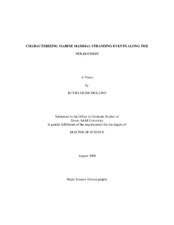| dc.description.abstract | The Texas Marine Mammal Stranding Network (TMMSN) is a valuable data resource for the marine mammal community. Limitations of funding and personnel severely impact the ability of the Network to maintain impeccable databases. This research constructed an application to address database complications and focused on investigating the species identification, temporal and spatial trends for stranding events along the Texas coast.
From 1980 to 2004, Tursiops truncatus accounted for approximately 80% of all stranding events. The remainder was 20 additional whale and dolphin species known to reside in the Gulf of Mexico. Tursiops truncatus strand along the entire coastline and are the only species stranding in the bays. All other species stranding are most dense along the southern coastline.
The temporal scales of events revealed no linear patterns from 1980 to 2004. A unique cyclic fluctuation occurred from 1992 to 1998, including the highest yearly counts and one isolated mortality event in Port Aransas. Attempts to forecast stranding events beyond 2004 were inconclusive due to multiple factors influencing a stranding event. A bimodal seasonal trend was evident, with events peaking in the spring and fall months. Density distributions by decade isolated three frequent stranding areas: Sabine-Galveston-Brazoria counties, Galveston Shipping Channel, and Corpus Christi Shipping Channel. The final aspect analyzed spatial elaboration of events by creating six location values to describe the Texas coastline. Each event was assigned from the geographical location and the orientation of an event along the coastline. Analysis revealed the segregation of Tursiops truncatus in the bays and confirmed earlier results of density distributions. Examining the locations by time revealed a specific incident connected to a mortality event in 1992, accounting for 59% of the stranding events. Location categories were compared to the TMMSN stranding regions and the regions experienced different location frequencies.
This study demonstrated how to construct a stronger database and the necessity for database accuracy. Study conclusions demonstrated the need to better isolate and research factors responsible for event distributions in time and space along the Texas coast to forecast the magnitude and location of stranding events to better aid the TMMSN response efforts. | en |


